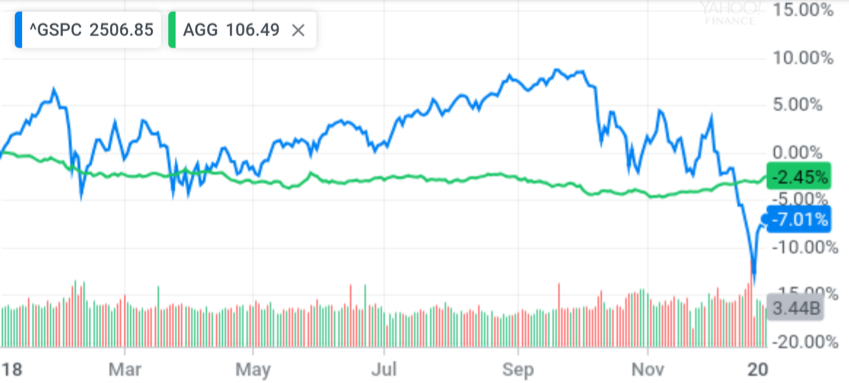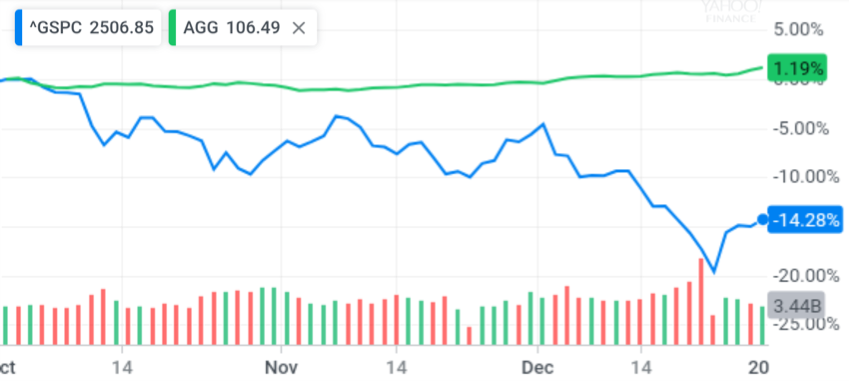Dear Investors,
Well, it was a doozy of a market this last month, ending a doozy of a year. As of Christmas Eve we were having the worst average daily return for all three major indexes since 1987, which is saying something. The next couple of days we saw a big bounce back, landing the S&P 500 down over -7% for the year as of close of market Monday, December 31st (see chart below).
2018 Performance of S&P 500 (^GSPC) vs iShares Barclays Aggregate Bond (AGG)

As of 12/31/2018
But it’s not like we started the year off on great footing. Some of you may remember that earlier last year in January, the Dow plunged 1,175, the worst point decline in history, continuing to plummet more than 3,200 points or -12% in just two weeks. Indeed, most of the year the stock market was just recuperating to get back to where it was at its peak in mid-January.
That is, until October, since which the market has slipped over -14% (see chart below).
Q4 Performance of S&P 500 (^GSPC) vs iShares Barclays Aggregate Bond (AGG)

As of 12/31/2018
None of this volatility is a surprise. We’ve been predicting a market correction and highlighting the probability of another recession since 2016 (see our December 2016 blog post: Investment Strategies for a Trump Administration). And even though it’s not a surprise, it’s always unsettling for us when the market is in turmoil, especially when the turmoil is on the way down instead of up.
During times like these, it’s important to remember a couple of things:
- Take the long view: Day to day headlines, like ones cited in this letter, are not the best basis for making strategic, long-term investment decisions. Unless you need to use all your funds in the next several years for a major necessary purchase (car, plane, island), then the day-to-day rise and fall of the market isn’t relevant to daily life. For some reference, after the 50%+ drop in the market in 2008-2009, it took just 4 years for stocks to recover.
- Set aside cash: If there are major purchases that you see in the next 3-5 years, this is still a fine time to move money to cash for them. The S&P 500, as of Monday had only erased gains back to May 2017 leaving intact 8 years of gains. If you need funds, don’t start counting from the top value of your investment account as a target you have to hit before you can make protective sells.
- Markets go up and down: The kind of market movements like we’ve seen this month have been exactly what we’ve been positioning accounts in anticipation of for the last two years. It’s not a question of if a recession will happen but when. And we don’t know whether this is really the beginning of a broader business cycle or just a really volatile month. The average time between recessions in the United States history is just over 4 years, and we are currently going into year 10 since our last recession, which is the longest period between recessions in U.S. history.
- Invest in quality: As politics and business cycles gyrate, well-managed companies will continue to sell their goods and services for a profit, even through downturns and expansions. Good portfolio managers can tune out the “noise” and make investment selections based on fundamental analysis, to choose quality stocks allocated in sectors with thriving futures.
So what’s next?
As we navigate our client’s portfolios through this volatile period, we continue to refine our Risk Parity Impact (RPI) models, use high-impact alternative assets, tactical portfolio moves, and tax-efficient green-bonds to help maximize returns and reduce the risks, always mindful of our investment impact.
- Risk Parity Impact: Our version of Risk Parity investing takes into consideration social and environmental impact objectives of our clients. We call them our Risk Parity Impact (RPI) models. While the portfolios didn’t participate in all of the upward volatility of the last two years, they also haven’t participated in all of the downturn. Over the last three months of 2018 the S&P 500 dropped -14.28% compared to our RPI Retirement Model which was only down -2.8%. Over the last three years the S&P 500 is up 8.34% while our RPI Retirement Model is up 4.48%. For defensive “buckets” in a portfolio, the RPI models will be one option to consider in 2019.
- Alternative, High-Impact Investments: One way we achieve lower volatility is by investing less money in publicly traded stocks, allocating more into low-correlated assets. While the stock market plunged this year, many of our client’s private placement holdings in real estate or renewable energy assets for example, that don’t trade on an exchange, held their values strong. As some of these funds come due in 2019, we’ll be offering reinvestment opportunities in several high-impact, alternative investments. Some of the criteria we used to identify these funds include their low correlation with the stock market, dividend payments to investors, proven track record and planned liquidity strategies. We expect to roll out these investment offerings to clients throughout this next year.
- Dollar-Cost Average: As part of a more tactical, asset allocation strategy these past two years, we’ve advised many investors to wait on placing cash into the markets. In 2019 we may suggest some clients begin to dollar-cost average monies not needed in the near-term, back into stocks over the next 12-18 months, especially if we see continued instability in broader economic conditions.
- Laddered Tax-Free Green Bonds: When adjusting the overall allocation during shifting markets, we have to consider the implications of bond investments. The Feds raised rates four times in 2018 year, and are expected to raise them three more times in 2019. From a planning perspective this is good news for savers, who are finally starting to earn a little on cash equivalent holdings. However for bond investments, rising interest rates means that the value of any previously-acquired bonds will have dropped. In order to mitigate the impact on our bond portfolios with enough assets, we ladder out the issues and continuously replace bonds as they come due, buying newer, more competitive bonds. This has allowed us to purchase more and more double tax-free green bonds offering higher and higher yields as interest rates rise, and we’ll continue this strategy throughout next year.
In sum….
Skidding into 2019, the markets have been anything but boring this past year and with rising interest rates, ongoing political upheaval, a looming trade war with China and the unresolved terms of Brexit, there are many roads we could see leading us into an economic contraction, or recession. Even currently, after this last quarter, we are still experiencing historically high stock market prices relative to company earnings.
In preparation of this next cycle, we’re positioning investors to mitigate their losses and earn competitive returns with positive impacts through various tactics. Each client of ours is unique, and no two portfolios are exactly the same. Please don’t hesitate to contact us if you would like to discuss this or any other questions or concerns you might have.
Best of wishes to you and your family in the new year, from all of us,
Impact Investors Team

